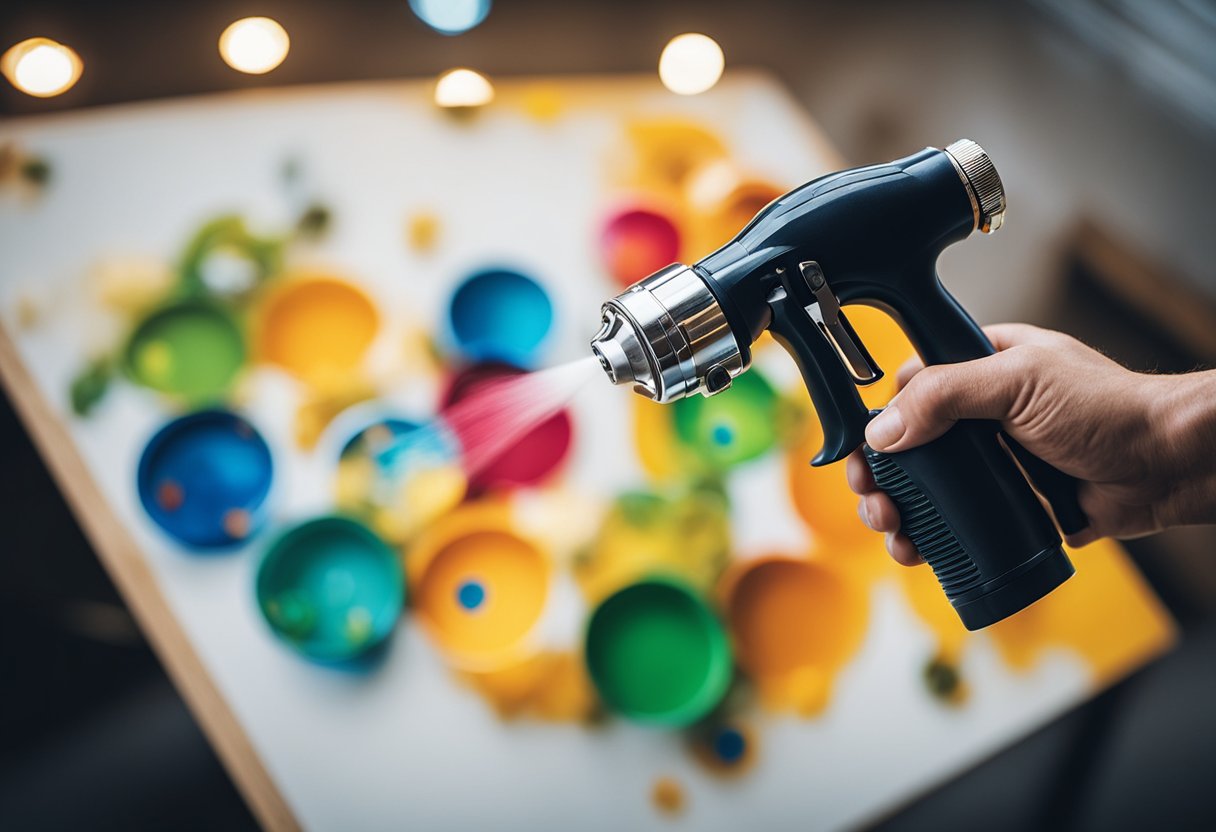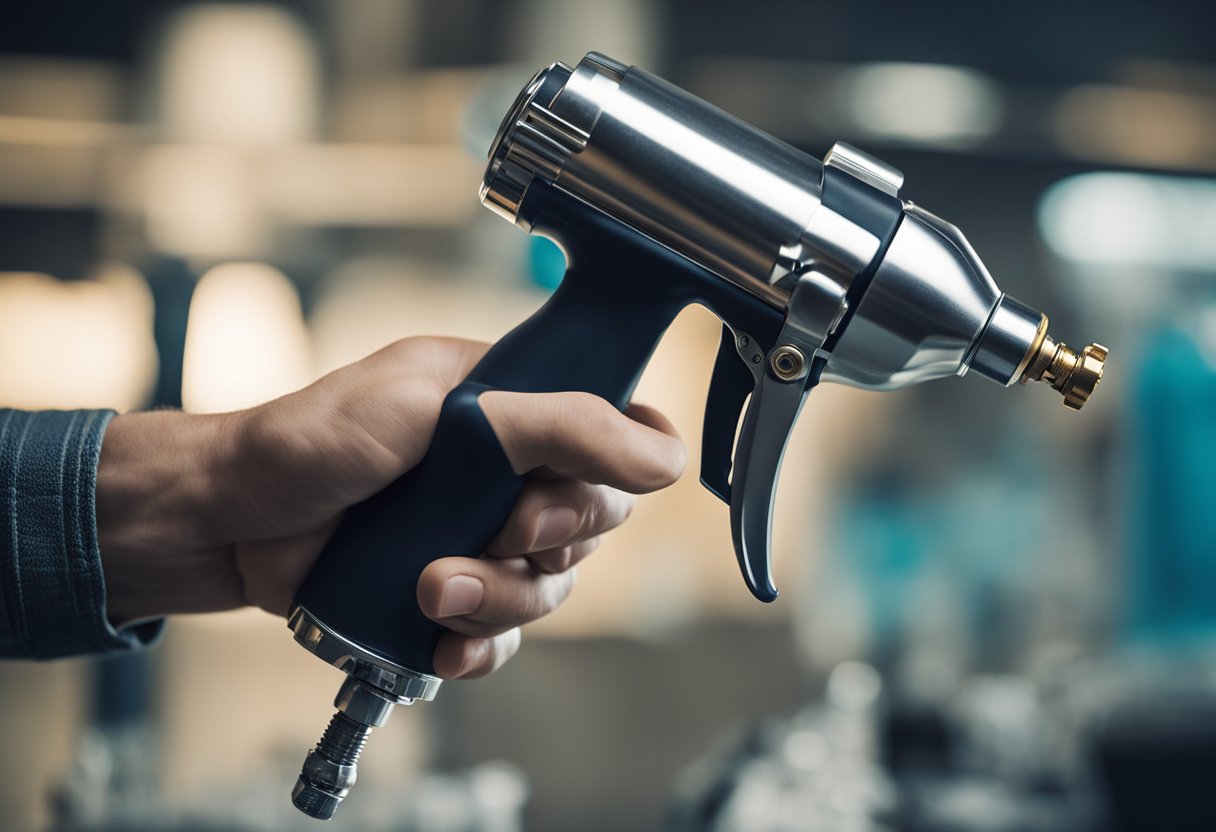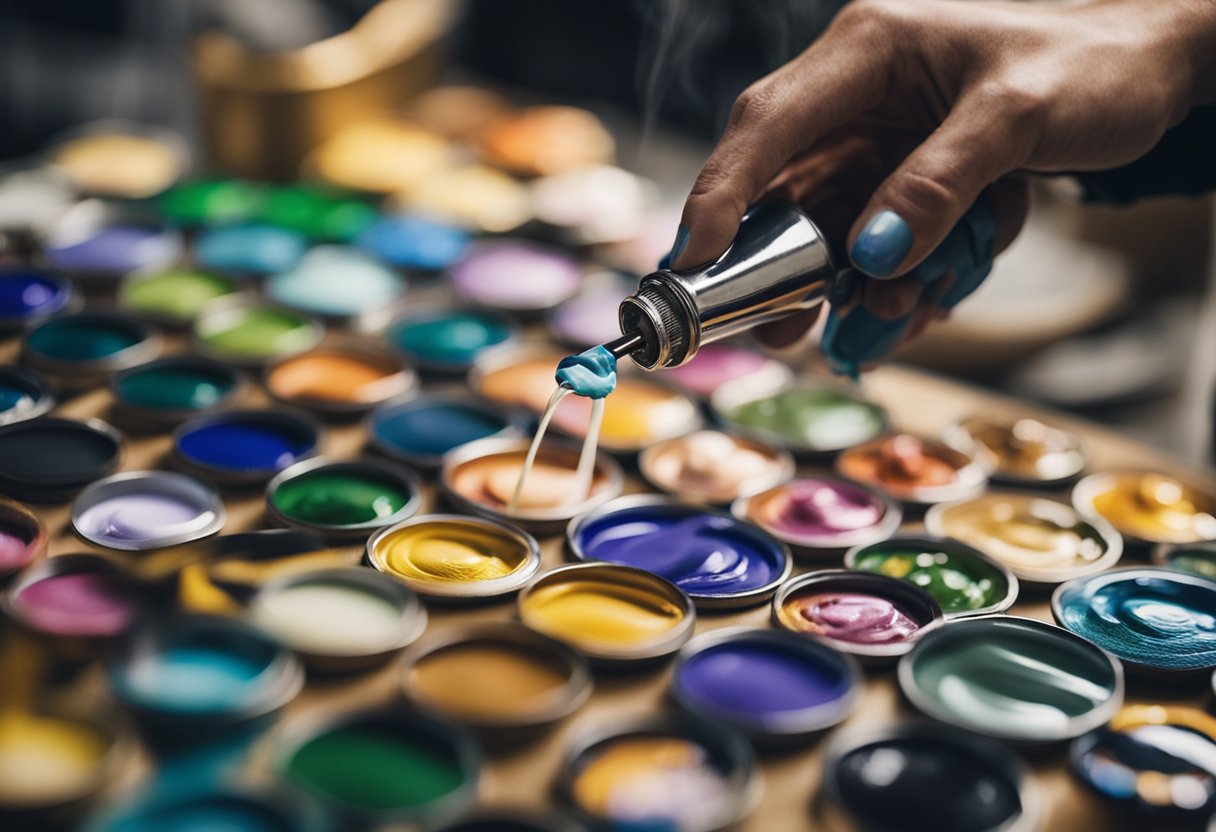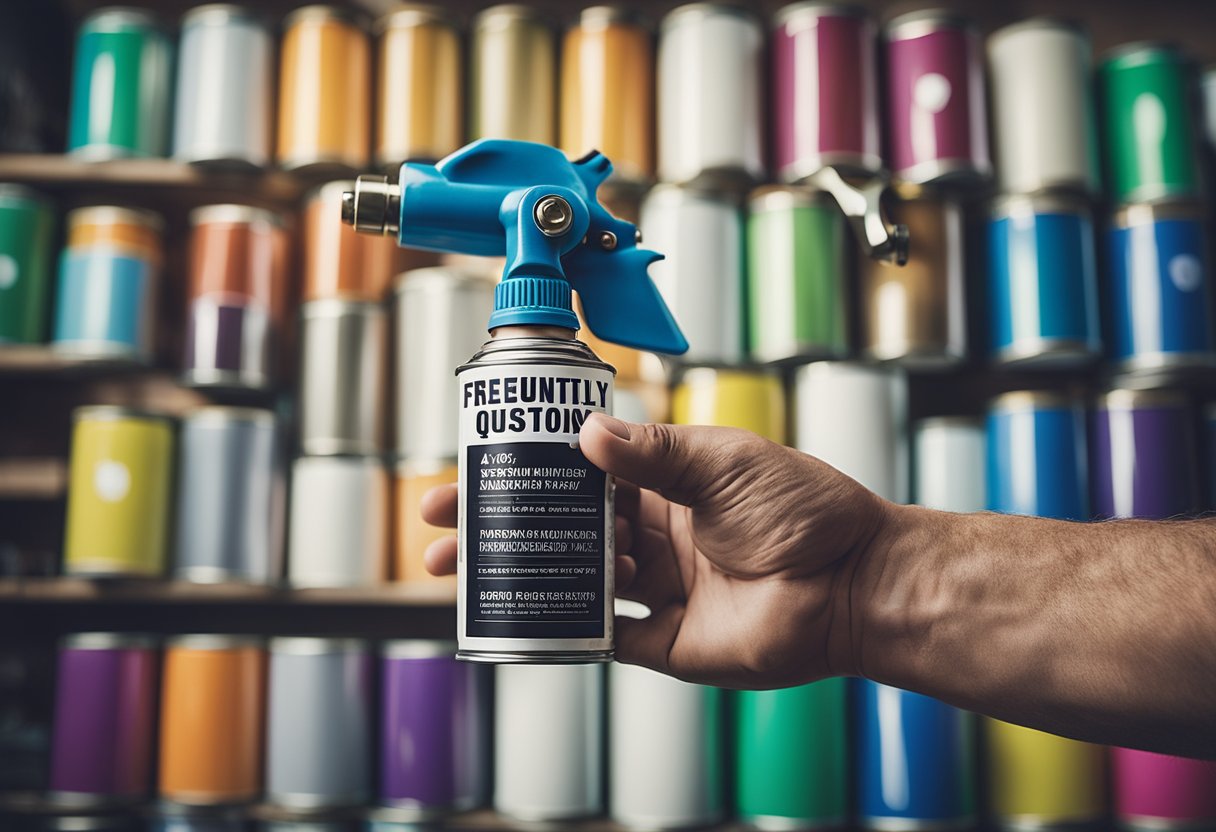As someone who has used acrylic paint for spray gun for many years, I can attest to the fact that it is a versatile and popular medium for both professional and amateur painters. Whether you are painting a car, a piece of furniture, or a canvas, using a spray gun can help you achieve a smooth, even finish that is difficult to achieve with other painting methods.
Understanding acrylic paint for spray gun is essential if you want to achieve the best results. Acrylic paint is a water-based paint that is known for its fast drying time, durability, and versatility. It can be used on a wide range of surfaces, including metal, wood, plastic, and canvas. When using acrylic paint with a spray gun, it is important to choose the right viscosity, thin the paint properly, and address common issues such as clogging and overspray.
Key Takeaways
- Understanding the properties of acrylic paint is crucial for achieving a professional-looking finish with a spray gun.
- Properly thinning the paint and choosing the right viscosity are key factors in achieving the desired results.
- Addressing common issues such as clogging and overspray can help you avoid frustration and achieve a smooth, even finish.
Understanding Acrylic Paint for Spray Gun
https://www.youtube.com/watch?v=JfHi5Kiqhto&embed=true
Acrylic paint is a popular choice for spray gun users because it is water-based and dries quickly. It is also easy to clean up and can be used on a variety of surfaces. When using acrylic paint in a spray gun, it is important to understand a few key things.
Firstly, it is important to thin the paint properly. Acrylic paint is often too thick to be sprayed through a gun, so it needs to be thinned down to the correct consistency. The amount of thinning required will depend on the type of spray gun being used and the size of the nozzle. Generally, a 1:1 ratio of paint to water is a good starting point. However, it is important to follow the manufacturer’s instructions for the specific paint being used.
Secondly, it is important to choose the right type of spray gun. There are two main types of spray guns: HVLP (high volume, low pressure) and conventional. HVLP guns are generally more efficient and produce less overspray, making them a popular choice for beginners. Conventional guns, on the other hand, are better for larger jobs and can produce a higher quality finish.
Lastly, it is important to practice proper technique when using a spray gun with acrylic paint. This includes holding the gun at the correct distance from the surface, moving the gun in a smooth and even motion, and overlapping each pass slightly to ensure even coverage. It is also important to wear proper safety gear, including a respirator and goggles, to protect yourself from the paint fumes and overspray.
In summary, understanding acrylic paint for spray gun requires proper thinning, choosing the right type of spray gun, and practicing proper technique. With these considerations in mind, users can achieve a high-quality finish on a variety of surfaces.
The Role of Viscosity in Spray Painting
https://www.youtube.com/watch?v=iPdjoDGe1mk&embed=true
As someone who has been using acrylic paint with a spray gun for a while, I can say that viscosity is one of the most important factors to consider when spray painting. Viscosity refers to the thickness or fluidity of the paint, and it plays a vital role in determining the spray pattern and overall finish of the painting.
When the viscosity of the paint is too high, it can clog the spray gun nozzle, resulting in an uneven spray pattern and an overall poor finish. On the other hand, if the paint is too thin, it can run and drip, leading to a mess and a lack of control.
To ensure that the viscosity of the paint is just right, it is essential to thin the paint to the correct consistency before spraying. The amount of thinning required depends on the type of spray gun used, the air pressure, and the specific type of acrylic paint being used.
One way to determine the correct viscosity is to use a viscosity cup, which measures the time it takes for the paint to flow through a small hole. The ideal flow time varies depending on the type of acrylic paint being used, but generally, it should be between 15-30 seconds.
In addition to using a viscosity cup, it is also essential to mix the paint thoroughly before spraying. This ensures that the paint is well-mixed and that the pigments are evenly distributed, resulting in a consistent finish.
Overall, the role of viscosity in spray painting cannot be overstated. By ensuring that the paint is thinned to the correct consistency and mixed thoroughly, you can achieve a smooth, even spray pattern and a professional-looking finish.
Thinning Acrylic Paint for Spray Gun
https://www.youtube.com/watch?v=YstVkA9msiw&embed=true
When it comes to thinning acrylic paint for a spray gun, it is important to choose the right thinning medium based on the type of spray gun you are using and the desired consistency of the paint. In this section, I will guide you through the process of thinning acrylic paint for a spray gun.
Choosing the Right Thinning Medium
The most common thinning mediums for acrylic paint are water, acrylic thinner, and acrylic flow improver. Water is the most readily available and affordable option, but it can break down the binding agents in the paint and cause it to lose its properties. Acrylic thinner is a more effective option, but it can be toxic and should only be used in a well-ventilated area. Acrylic flow improver is a newer type of medium that is designed to improve the flow and leveling of acrylic paint without affecting its properties.
Step by Step Thinning Process
-
Start by pouring the desired amount of acrylic paint into a mixing container.
-
Add a small amount of the chosen thinning medium to the paint and mix it thoroughly with a stir stick. The amount of thinning medium you add will depend on the type of spray gun you are using and the desired consistency of the paint. As a general rule, you should start with a 1:10 ratio of thinning medium to paint and adjust it as needed.
-
Test the consistency of the paint by dipping a viscosity cup into the mixture and timing how long it takes for the paint to flow through the cup. If the paint is too thick, add more thinning medium and test it again. If it is too thin, add more paint and test it again.
-
Once you have achieved the desired consistency, strain the paint through a mesh strainer to remove any impurities.
-
Pour the thinned paint into the spray gun and test it on a scrap piece of paper or cardboard to make sure it is spraying evenly and smoothly.
Remember to always use distilled water when thinning acrylic paint, as tap water can contain impurities that can affect the performance of the paint. Additionally, you can use a thinning agent or solvent to thin the paint, but make sure to follow the manufacturer’s instructions and use it in a well-ventilated area.
By following these steps and choosing the right thinning medium, you can achieve a smooth and even finish when using acrylic paint with a spray gun.
Addressing Common Issues in Spray Painting
https://www.youtube.com/watch?v=4V8zNfZJf0s&embed=true
When using acrylic paint with a spray gun, there are a few common issues that can arise. In this section, I will discuss two of the most common issues and provide tips on how to prevent and fix them.
Preventing and Fixing Drips
One of the most frustrating issues that can occur when spray painting is drips. Drips can happen for a variety of reasons, such as using too much paint, holding the spray gun too close to the surface, or not using the correct technique.
To prevent drips, it’s important to use the correct technique when spray painting. Hold the spray gun at the correct distance from the surface, typically 6 to 8 inches away, and move the gun in a smooth, continuous motion. It’s also important to use a filter to remove any lumps or debris from the paint before spraying.
If you do get drips, the best way to fix them is to wait for the paint to dry and then sand them down. Use a fine-grit sandpaper and be careful not to sand too much, as this can create an uneven surface.
Avoiding Streaks and Peeling
Another common issue when spray painting with acrylic paint is streaks and peeling. Streaks can occur if the paint is not applied evenly, while peeling can happen if the paint is not allowed to dry properly.
To avoid streaks, make sure to apply the paint in thin, even coats. Allow each coat to dry completely before applying the next one. It’s also important to use the correct technique when spray painting, as holding the spray gun too close to the surface can cause streaks.
To avoid peeling, make sure to allow the paint to dry completely between coats. If the paint is not allowed to dry properly, it can peel or flake off. It’s also important to use the correct type of paint for the surface you are painting, as some paints are not suitable for certain materials.
By following these tips, you can prevent and fix common issues when spray painting with acrylic paint. Remember to use the correct technique, use a filter to remove any lumps or debris, and allow the paint to dry completely between coats. With a little practice, you can achieve a smooth, even finish every time.
Choosing the Right Spray Gun
https://www.youtube.com/watch?v=d60IXF0ng6U&embed=true
When it comes to using acrylic paint with a spray gun, choosing the right spray gun is crucial. The wrong spray gun can lead to uneven application, overspray, and other issues that can ruin your project. Here are some factors to consider when selecting a spray gun for acrylic paint:
HVLP Spray Gun
High Volume Low Pressure (HVLP) spray guns are ideal for acrylic paint because they use less air pressure to atomize the paint, resulting in less overspray. This means more paint goes where you want it, and less goes where you don’t. HVLP spray guns are also more efficient than other types of spray guns, so you’ll use less paint overall.
Compressor
The compressor you use with your spray gun is just as important as the spray gun itself. You’ll need a compressor with enough power to keep up with your spray gun, so make sure you check the manufacturer’s recommendations. A compressor that’s too small won’t provide enough pressure, while one that’s too large will waste energy and money.
Spray Pattern
The spray pattern of your spray gun is another important factor to consider. The spray pattern should be adjustable, so you can change it to suit your needs. A narrow spray pattern is best for small areas, while a wider spray pattern is better for larger areas. Make sure you choose a spray gun with a pattern that suits your project.
Overspray
Overspray is a common problem with spray guns, but it can be minimized by choosing the right spray gun and adjusting the spray pattern. HVLP spray guns are the best choice for minimizing overspray, but you can also reduce overspray by using a spray gun with a narrow spray pattern and adjusting the air pressure to suit your needs.
By considering these factors, you can choose the right spray gun for your acrylic paint project and achieve professional-looking results.
Achieving a Professional-Looking Finish
As someone who has used acrylic paint with a spray gun for many years, I can attest to the fact that achieving a professional-looking finish is not as difficult as it may seem. With a few simple tips and tricks, you can create a durable finish that will look like it was done by a professional.
First, it’s important to choose the right paint for your project. Look for a high-quality acrylic paint that has good opacity and adhesion. This will ensure that your paint goes on smoothly and sticks to the surface you are painting.
Next, make sure you prepare your surface properly. Clean it thoroughly and sand it if necessary to ensure that the paint will adhere properly. If you are painting over a previously painted surface, make sure to remove any loose or flaking paint before you begin.
When it comes to actually spraying the paint, it’s important to use the right technique. Hold the spray gun about 6-8 inches away from the surface and move it in a smooth, even motion. Don’t try to cover the entire surface in one pass – instead, make multiple passes to build up the color and achieve even coverage.
Finally, make sure to let the paint dry completely before handling the object. This will ensure that the paint has a chance to fully cure and will be as durable as possible.
By following these simple tips, you can achieve a professional-looking finish with acrylic paint and a spray gun. With a little practice and patience, you’ll be able to create beautiful, long-lasting finishes on all of your projects.
Understanding Other Types of Paints for Spray Gun
As an expert in acrylic paint for spray guns, I understand that not all paints are created equal. There are various types of paints that can be used with spray guns, each with its own unique properties and characteristics. In this section, I will provide a brief overview of some of the most common types of paints for spray guns.
Latex Paint
Latex paint is a water-based paint that is commonly used for interior and exterior walls. It is easy to clean up with soap and water, and it dries quickly. However, latex paint can be difficult to spray with a spray gun because it is thick and can clog the nozzle. To use latex paint with a spray gun, it needs to be thinned down with water or a paint thinner.
Oil-Based Paint
Oil-based paint is a type of paint that is made with a solvent such as mineral spirits or turpentine. It is commonly used for painting furniture, cabinets, and trim. Oil-based paint is thicker than latex paint, and it takes longer to dry. It is also more difficult to clean up than latex paint. When using oil-based paint with a spray gun, it needs to be thinned down with a solvent.
Lacquer Paint
Lacquer paint is a type of paint that is commonly used for painting cars and other vehicles. It is a high-gloss paint that dries quickly and is very durable. Lacquer paint is also very thin, which makes it ideal for use with a spray gun. However, it is important to note that lacquer paint contains volatile organic compounds (VOCs), which can be harmful to your health if inhaled. Proper ventilation is required when using lacquer paint.
Tinted Paint
Tinted paint is a type of paint that has been mixed with a colorant to create a specific color. It can be either water-based or oil-based, and it can be used for a variety of applications. When using tinted paint with a spray gun, it is important to follow the manufacturer’s instructions for thinning and application.
Airless Paint
Airless paint is a type of paint that is sprayed without the use of air. It is commonly used for painting large surfaces such as walls and ceilings. Airless paint sprayers are designed to pump paint through a hose and out of a spray gun at high pressure. This allows for a more even and consistent application of paint.
In conclusion, understanding the different types of paints for spray guns is important for achieving the desired results. Each type of paint has its own unique properties and characteristics, and it is important to choose the right type of paint for your specific project. When using any type of paint with a spray gun, it is important to follow the manufacturer’s instructions for thinning and application.
Frequently Asked Questions
How do you thin acrylic paint for use in a spray gun?
The process of thinning acrylic paint for use in a spray gun is relatively straightforward. First, determine the type of paint and the appropriate thinners to use. Next, prepare the paint by stirring it thoroughly. Then, start with a low ratio of thinner to paint and gradually increase the ratio until the desired consistency is achieved. Finally, blend the paint and thinner thoroughly and conduct a test spray to ensure that the mixture is appropriate for use in the spray gun. 1
What is the best technique for spraying acrylic paint with an HVLP gun?
The best technique for spraying acrylic paint with a High Volume Low Pressure (HVLP) gun is to use a consistent, even motion. Hold the gun perpendicular to the surface being painted and move it across the surface at a steady pace. Avoid stopping or starting abruptly, as this can result in uneven coverage. Additionally, be sure to adjust the air pressure and fan width to achieve the desired spray pattern. 2
Can you use water to thin acrylic paint for a spray gun?
Yes, it is possible to use water to thin acrylic paint for use in a spray gun. However, it is important to note that water can affect the quality and durability of the paint. For this reason, it is recommended to use a commercial paint thinner or other appropriate thinning agent instead of water whenever possible. 3
What is the process for spraying acrylic enamel car paint?
The process for spraying acrylic enamel car paint is similar to that of spraying other types of acrylic paint. First, prepare the surface to be painted by cleaning and sanding it as necessary. Then, apply a primer and allow it to dry completely. Next, mix the paint and thinners according to the manufacturer’s instructions and load the paint into the spray gun. Finally, apply the paint in even, overlapping strokes, being careful to maintain a consistent distance from the surface being painted. 4
What pressure should you use when spraying acrylic paint with an airless gun?
The pressure used when spraying acrylic paint with an airless gun will depend on the specific gun being used and the viscosity of the paint. However, as a general rule, a pressure of 2000-2500 PSI is typically appropriate for most acrylic paints. It is important to consult the manufacturer’s instructions for the specific gun and paint being used to ensure that the correct pressure is applied. 1
Is it possible to use acrylic paint with an air gun?
Yes, it is possible to use acrylic paint with an air gun. However, it is important to ensure that the paint is properly thinned and that the gun is adjusted to the appropriate spray pattern and air pressure. Additionally, it is recommended to use a high-quality air gun and to follow all manufacturer’s instructions and safety guidelines to ensure the best results. 2
Footnotes

Hi, I’m Sal Muller of Tooltrip.com. My DIY experience led me to understand essential power tools for home projects. Tooltrip.com guides enthusiasts and professionals in choosing right tools for any job. I provide concise top tool reviews for easier, efficient DIY.





